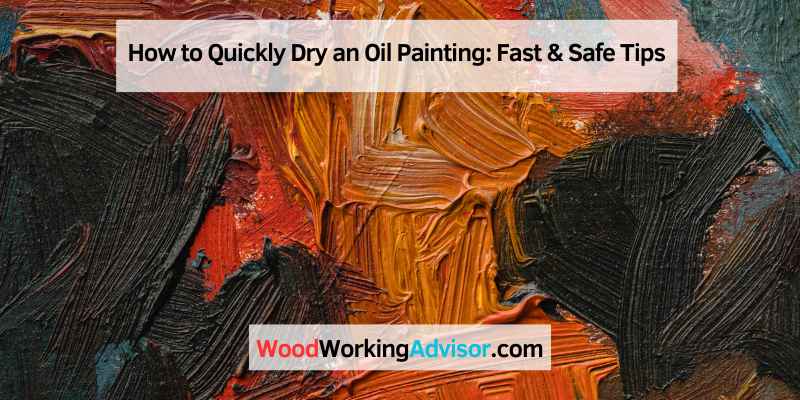To quickly dry an oil painting, use a fan to increase air circulation and place the painting in a warm room. Avoid direct sunlight to prevent damage.
Drying oil paintings can be a slow process due to their thick layers and oil content. Artists often seek faster methods to expedite this process without compromising the artwork’s quality. Using a fan to improve air circulation is effective. Placing the painting in a warm, dry room can also help.
These techniques speed up the drying time significantly. It is crucial to avoid direct sunlight, as it can cause cracking and fading. With these tips, artists can ensure their oil paintings dry more quickly and safely.
The Challenge Of Drying Oil Paintings
Speeding up the drying process for oil paintings involves using thinner layers and adding drying agents. Proper ventilation and moderate heat can also help.
Oil paint is thick and slow to dry. It needs air to dry fully. The paint contains oil that slows drying. This oil takes time to harden. Layers of paint can trap oil inside. This makes drying take longer. Some colors dry faster than others.
| Factor | Effect on Drying |
|---|---|
| Thickness of Paint | Thicker paint dries slower. |
| Type of Oil | Linseed oil dries faster. |
| Humidity | High humidity slows drying. |
| Temperature | Warm temperatures speed up drying. |
Preparation Before Painting
Pick oil paints that dry faster. Alkyd oil paints are a good choice. Use a canvas that absorbs oil well. Linen canvases work best for quick drying. Thin your paints with a fast-drying medium. Liquin is a popular choice.
Place your canvas in a dry, warm room. A fan can help the drying process. Ensure the room is dust-free. Dust can stick to wet paint. Use a clean, flat surface to work on. Keep your brushes and tools clean. Dirty tools can slow drying.
Effective Techniques To Speed Up Drying
Apply thin layers of paint. Thin layers dry faster than thick ones. Use the fat over lean method. This means using less oil in lower layers. Add more oil in upper layers. This helps each layer dry properly.
Mix a drying medium with your paint. This speeds up drying time. Linseed oil is one example. It helps paint dry faster. Apply it carefully to avoid cracks.
Temperature And Humidity Control
Oil paintings dry best at 70°F to 75°F. Humidity should stay below 50%. Use a dehumidifier if needed. Keep the area well-ventilated. This helps the paint dry faster. Avoid rooms with high moisture. Basements and bathrooms are not ideal. Choose a dry, warm room instead.
Fans can help circulate air. Place the fan away from the painting. This avoids dust landing on wet paint. Use a heater to maintain warmth. Keep it a safe distance from your painting. Direct sunlight can also help. Place the painting near a window. Make sure it gets indirect sunlight. This will speed up the drying process.
Safe Use Of Heat To Dry Paintings

Using heat to dry oil paintings can speed up the process. Carefully apply mild heat to avoid damaging the artwork. Ensure proper ventilation to prevent overheating.
Appropriate Heat Sources
Use a hairdryer set on low heat. Keep it at least 12 inches away. A fan can also help speed up drying. Place the painting in a warm room. Avoid direct sunlight. It can cause cracks.
Avoiding Heat Damage
Do not use high heat. It can ruin the painting. Keep the heat source moving. Never focus on one spot for too long. Check the painting often. Make sure it is drying evenly. Be patient and careful.
Lighting And Ventilation Tips
Natural light helps dry oil paint faster. Place your painting near a window. Avoid direct sunlight, as it can harm the paint. Natural light provides even drying. This method is energy-efficient. It is also eco-friendly. Natural light helps you see your painting better. Colors look true in natural light. This helps in better evaluation. Your painting process becomes easier.
Good air circulation speeds up drying. Use a fan to move air around. Open windows to let fresh air in. Avoid damp areas for drying paintings. Damp air slows down drying. Use a dehumidifier if needed. This removes moisture from the air. Proper air flow helps in even drying. This prevents unwanted cracks in paint. Air circulation also reduces odors.
Storage And Handling Of Wet Paintings
Ensure adequate ventilation to speed up oil painting drying. Use fans or dehumidifiers to reduce moisture levels. Apply thin layers of paint for quicker drying times.
Proper Placement
Keep the painting in a dry place. Avoid humid areas. Use a fan to increase air flow. Ensure the fan is at low speed. Too much wind can damage the paint. Place the painting on an easel. This allows air to circulate all around. Avoid laying the painting flat.
Protecting The Surface
Do not touch the wet paint. Use a cover to protect the surface. A cardboard box can work well. Make sure it does not touch the paint. Keep dust and dirt away. Clean the area around the painting. Use a light cloth to cover if needed. Ensure it does not stick to the paint.
Common Mistakes To Avoid
Rushing can ruin your painting. Oil paint needs time to dry. Each layer must dry before adding another. Skipping this step causes cracks. Thin layers dry faster than thick ones. Use patience for best results.
Use materials made for oil paint. Water-based products don’t mix well. This causes uneven drying and damage. Choose the right brushes and mediums. They help the paint dry properly. Store your painting in a dry place. This helps avoid moisture damage.

Frequently Asked Questions
How Can I Make My Oil Painting Dry Faster?
To make your oil painting dry faster, use quick-drying mediums, apply thin layers, and work in a well-ventilated area. Use a fan or a dehumidifier to speed up the drying process. Consider using alkyd-based paints for faster drying times.
Can I Dry Oil Paint With A Hair Dryer?
Using a hair dryer to dry oil paint is not effective. Oil paint dries through oxidation, not heat. Patience is key.
How Long Does It Take For Oil Paintings To Dry?
Oil paintings typically take 1-2 weeks to dry to the touch. Complete drying can take 6 months to a year.
How Do You Dry A Painting Fast?
To dry a painting fast, use a fan or hairdryer on a low setting. Place the painting in a warm, dry room. Ensure good ventilation to speed up the drying process. Avoid direct sunlight to prevent damage.
Conclusion
Mastering quick drying techniques for oil paintings can save you time and frustration. Use these tips to achieve better results. Keep experimenting with different methods to find what works best for you. With practice, you’ll create beautiful art without long drying times.
Happy painting!


